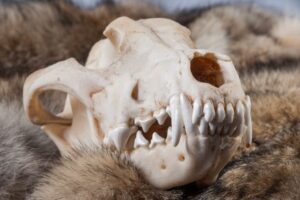You’ve caught a furbearer trophy, but now comes the hard part. A thorough skull cleaning is needed to properly display it. Providing one of the most effective ways to deflesh a specimen, a dermestid beetle colony can give you the results you need.
Here is a look into how cleaning small mammal skulls works:
What Are Dermestid Beetles?
They are beetles that eat the flesh off bones. In fact, dermestid larvae eat only the flesh of deceased animals. Thorough and effective, they avoid requiring tools to clean skulls, which can damage delicate nasal bones and other structures. Using flesh-eating beetles is often the preferred method of preparing skulls for display in museums and universities.
Dermestids are just a few millimeters long and have a lifespan of about four to five months. Their larvae are about the size of a pinhead and molt several times over five to six weeks, before burrowing and entering the pupa stage. They are effective eaters, but it often takes several thousand to consume the flesh of a large skull (you can get by with a colony of 300+ beetles for a single small skull).
How Dermestid Beetles Are Used for Skull Cleaning
Whether you’re a collector, hunter, or taxidermist, skull cleaning has many benefits. Bones are fully preserved and there are no traces of flesh to leave behind foul odors (except when the flesh is being consumed). Also, the beetles do not carry diseases. There is no weakening of bones or teeth either.
While Kodiak Bones & Bugs Taxidermy can process a sample you mail in, you can also buy beetles online to grow your own colony. Establishing a colony of flesh-eating larvae takes just a few weeks. Given the beetles’ lifecycle, you can feasibly create a self-sustaining colony of larvae and viable adults in a few months.
To accomplish this, you’ll need:
- A place to house the beetles, such as a large container, plastic tote, or aquarium.
- Substrates like shredded paper, mammal bedding, and Styrofoam for them to burrow in.
- Ample air circulation with a tight seal to keep beetles in and pests out.
Dermestids also need proper temperature and light to thrive. They are most active when it is from 65°F to 85°F. While they do fine on dried meat from your specimen, you can feed them meat scraps and fish in between cleanings.
Professional Cleaning with Kodiak Bones & Bugs Taxidermy

To learn more about using dermestid beetles with small furbearers and small mammals, and ethical taxidermy in general, contact us online or call 907-942-2847.

